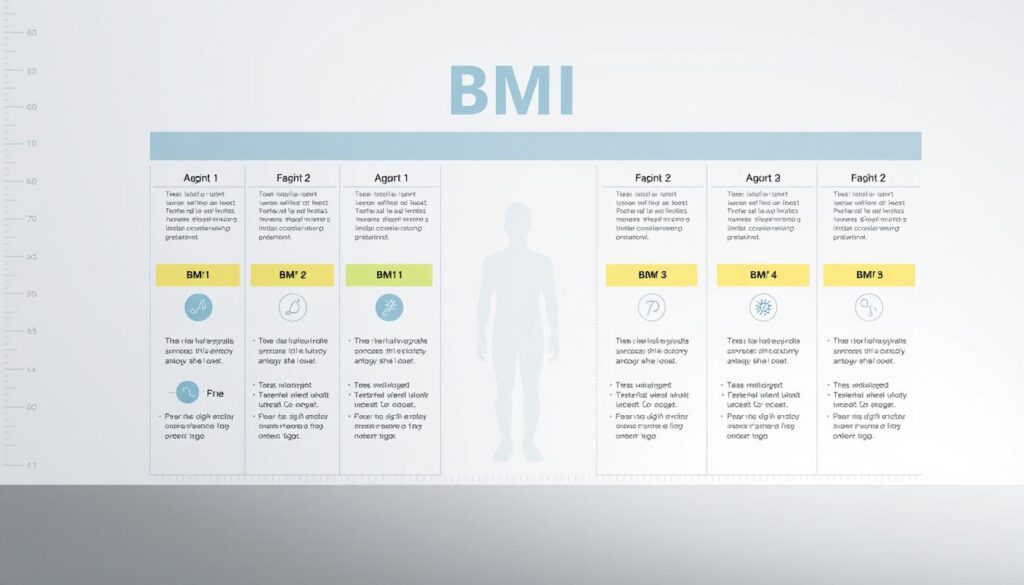Do you know your Body Mass Index (BMI)? It’s a key health indicator. BMI shows the ratio of your height to weight, estimating body fat. Knowing your BMI is a big step towards a healthy life.
We’ll show you how to calculate BMI manually. This skill is great for anyone wanting to track their health. By learning this, you can check your body fat and make smart health choices.
Key Takeaways
- Understand the concept and significance of BMI in health assessments.
- Learn the manual calculation method for determining BMI.
- Discover the importance of monitoring BMI for health and fitness goals.
- Gain insights into how BMI can be used as a tool for maintaining a healthy lifestyle.
- Explore the benefits of manually calculating your BMI.
Understanding Body Mass Index (BMI)
Body Mass Index (BMI) is key to checking our health and wellbeing. It’s a basic tool for doctors to see if our weight is right for our height.
What is BMI?
BMI is a simple way to figure out weight categories based on height and weight. It helps tell if someone has a healthy weight for their height.
Why is BMI Important?
BMI is crucial because it helps spot health risks linked to being underweight, overweight, or obese. For example, a high BMI might mean a higher risk of diabetes, heart disease, and some cancers. So, BMI is a great tool for doctors to talk about healthy weight with patients.
“BMI is not a direct measure of body fat, but it is a useful indicator of health risks associated with weight.”
BMI Categories Explained
The BMI categories are as follows:
- Underweight: BMI is less than 18.5
- Normal weight: BMI is 18.5 to 24.9
- Overweight: BMI is 25 to 29.9
- Obese: BMI is 30 or more

Knowing these categories is vital for spotting health risks and taking steps to prevent them. By understanding their BMI, people can start working towards a healthier life.
The Formula for Calculating BMI
The BMI formula is easy to follow once you know it. Body Mass Index (BMI) is a simple way to check your weight against your height.
“BMI is a person’s weight in kilograms divided by the square of height in meters,” says the World Health Organization. This is the core of how to calculate BMI by hand.
Metric vs. Imperial Measurements
If you use the metric system, the formula works straight away. But, if you’re on the imperial system (pounds and inches), you need to tweak it a bit. You multiply the result by 703 to get the right BMI.
For metric users, it’s weight (in kilograms) divided by height (in meters) squared. Imperial users, it’s weight (in pounds) divided by height (in inches) squared, then times 703.

Breaking Down the BMI Formula
Now, let’s get into the details of the BMI formula. The metric way is weight (kg) / height (m)2. For imperial, it’s (weight (lbs) / height (in)2) * 703. Knowing these formulas is key to calculating your BMI by hand.
Health experts say, “Knowing your BMI is a big step in checking your health risks and finding the right weight management plan.” By using the right formula and measurements, you can find your BMI and start working towards a healthier life.
Gathering Necessary Measurements
To start calculating your BMI, you need to get your height and weight right. It’s key to be precise with these numbers.
Measuring Height Accurately
Getting your height right is vital for a correct BMI. Stand on a flat surface without shoes, with your back against a wall. Make sure your heels are against the wall and your line of sight is level with the floor. Use a ruler or straight edge to mark the wall at the top of your head.
Then, measure the distance from the floor to this mark. For the best results, use a rigid measuring tape or a stadiometer.
Weighing Yourself Correctly
To weigh yourself right, use a trustworthy scale. It’s best to weigh yourself in the morning after using the bathroom and before eating or drinking. Stand on the scale without shoes and spread your weight evenly on both feet.
For more accuracy, weigh yourself a few times to get consistent readings.
Tools You May Need
You’ll need a few simple tools to get the measurements you need. These include a measuring tape or stadiometer for height, a reliable scale for weight, and a calculator for the BMI calculation.
| Tool | Use |
|---|---|
| Measuring Tape or Stadiometer | Measuring Height |
| Reliable Scale | Measuring Weight |
| Calculator | BMI Calculation |
By using these tools and following the tips, you can make sure your height and weight are accurate. This is crucial for a reliable BMI calculation.

Step-by-Step Calculation Process
Let’s explore how to calculate your BMI step by step. This method is easy and helps you grasp your body mass index.
Converting Height to Meters
The first step is to change your height to meters if it’s not already in metric units. If your height is in inches or feet, you need to convert it. For example, if you’re 5 feet 8 inches tall, first convert it to inches (68 inches). Then, multiply by 0.0254 to get meters.
Example: 68 inches * 0.0254 = 1.73 meters
Calculating Weight in Kilograms
If your weight is in pounds, you need to convert it to kilograms. To do this, divide your weight in pounds by 2.20462. For instance, if you weigh 150 pounds, your weight in kilograms is about 68 kilograms.
Formula: Weight in pounds / 2.20462 = Weight in kilograms
Applying the BMI Formula
Now, with your height in meters and weight in kilograms, you can calculate your BMI. The formula is BMI = weight (kg) / height (m)2. Let’s say your weight is 68 kg and your height is 1.73 meters. Your BMI would be 68 / (1.73)2.
| Height (m) | Weight (kg) | BMI Calculation | BMI |
|---|---|---|---|
| 1.73 | 68 | 68 / (1.73)2 | 22.72 |
| 1.60 | 55 | 55 / (1.60)2 | 21.48 |
Interpreting Your BMI Results
Your BMI is more than a number; it’s a health clue. After getting your BMI, it’s key to understand what it means. We’ll help you grasp your BMI numbers, find a healthy range, and what to do if it’s not.
What Your BMI Numbers Mean
BMI falls into several ranges, each showing a different health risk. Knowing these ranges is vital for making sense of your BMI.
- Underweight: BMI is less than 18.5
- Normal weight: BMI is 18.5 to 24.9
- Overweight: BMI is 25 to 29.9
- Obese: BMI is 30 or more
Healthy BMI Range
A healthy BMI is between 18.5 and 24.9. This range means your weight matches your height, lowering health risks.
Next Steps if BMI is Unhealthy
If your BMI shows you’re underweight, overweight, or obese, it’s time for action. You might need to change your diet, exercise more, or talk to a doctor for advice.
| BMI Category | BMI Range | Health Risk |
|---|---|---|
| Underweight | Less than 18.5 | Malnutrition, Osteoporosis |
| Normal weight | 18.5 to 24.9 | Low |
| Overweight | 25 to 29.9 | Moderate |
| Obese | 30 or more | High |
Visual Aids and Infographics
Visual aids make complex info like BMI easy to understand. They help us see how BMI affects our health quickly.
Simplifying Complex Information
Infographics show how to calculate BMI in simple steps. For example, they can make the BMI formula clear. You can find a BMI calculator on the Health Weight Calculator website.
Illustrating BMI Categories
Visual aids also show BMI categories and health risks. The American Heart Association has a detailed guide on their website. Infographics make it easy to see your health status and what steps to take.
Using visual aids and infographics makes understanding BMI easier and more fun. They help us grasp our health better and make smart choices.


